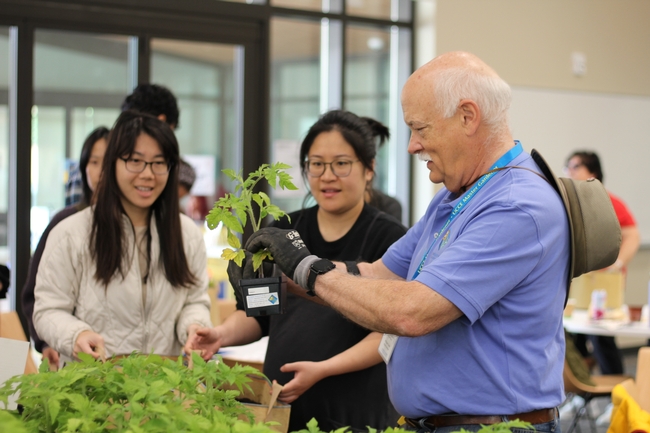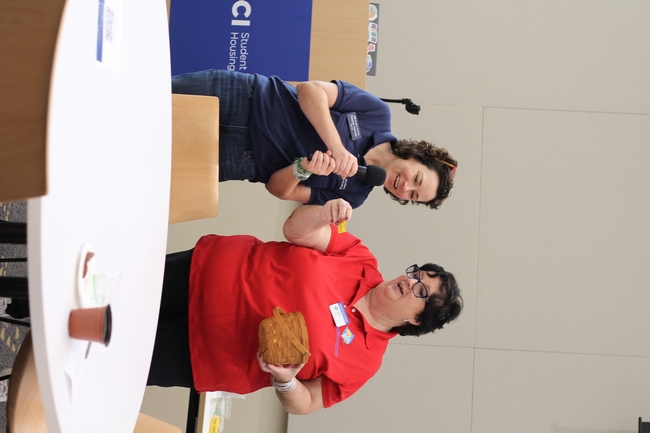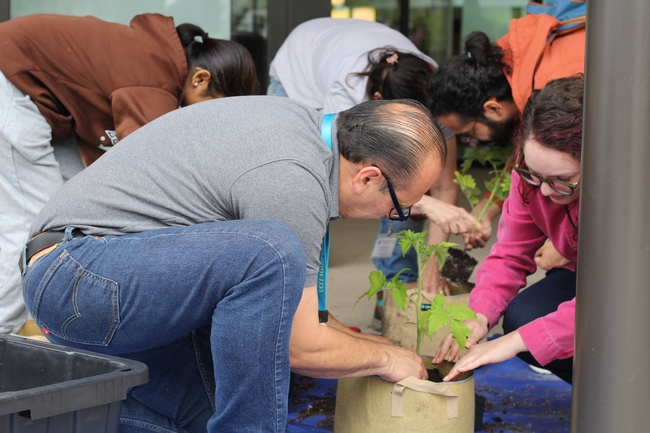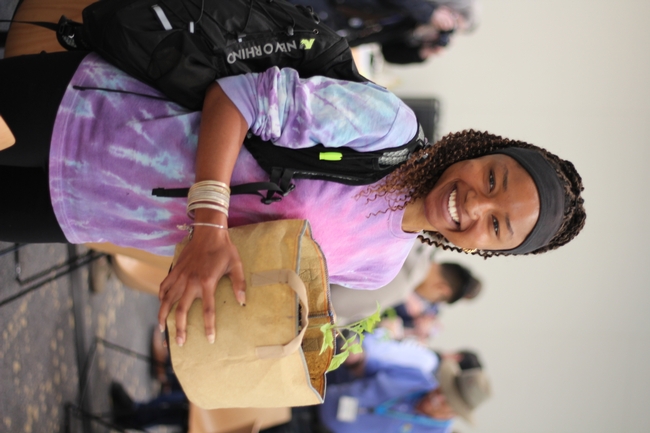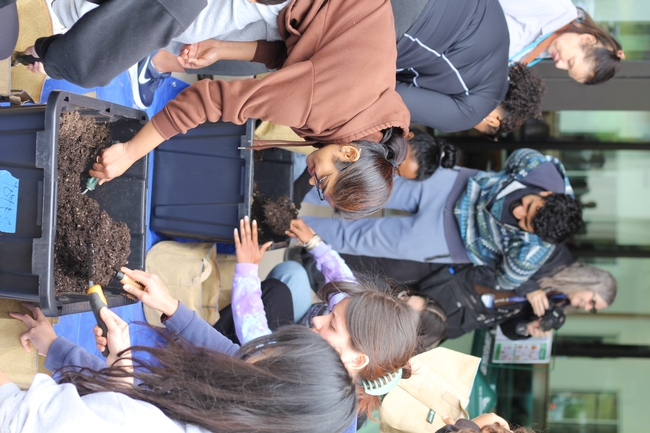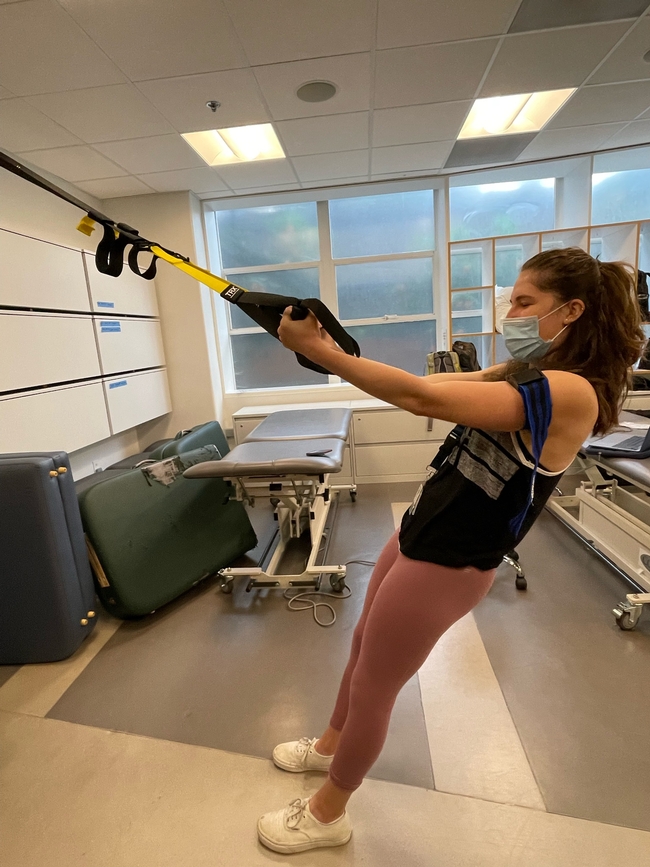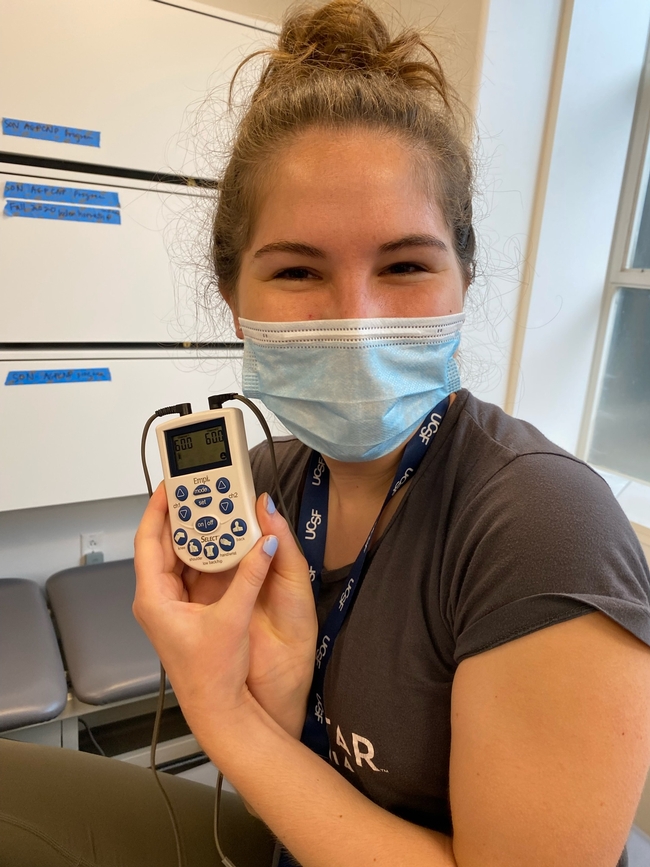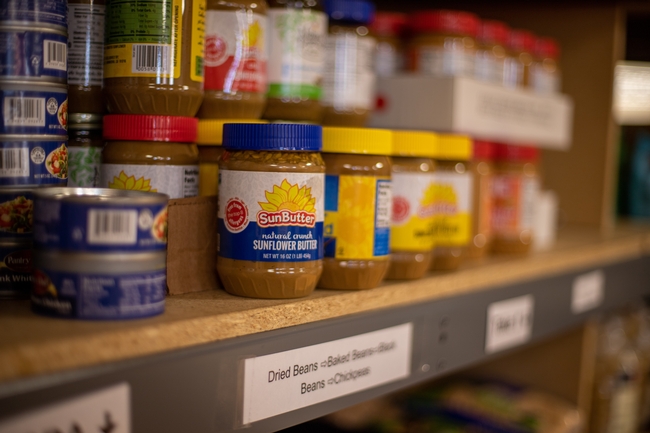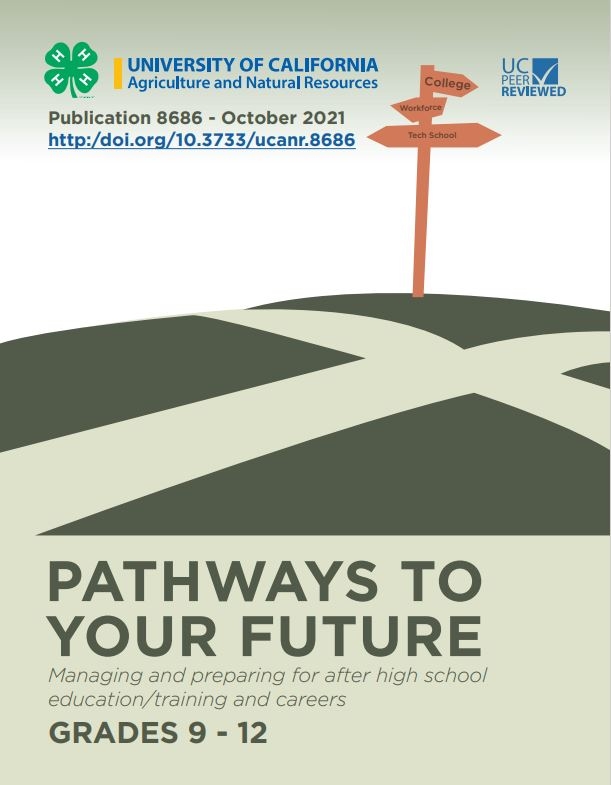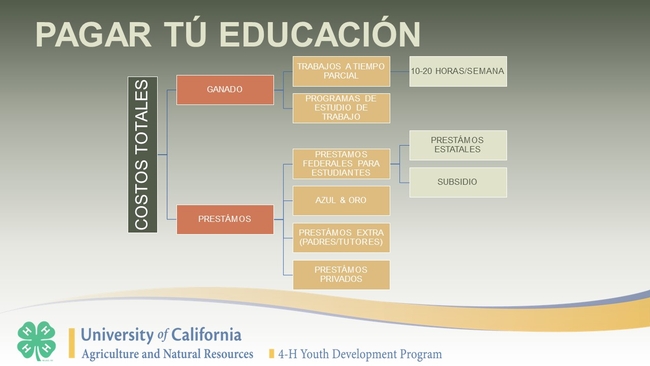- Author: Saoimanu Sope
Although training is required to become a University of California Master Gardener, the benefits of gardening can be experienced by anyone and everyone.
“As long as you're willing to get your hands dirty,” said Laurie Menosky, a UC Master Gardener volunteer in Orange County, “you can learn to grow all sorts of things.”
In early April, Menosky partnered with ETN Medical Infusion (a clinic in Orange County) and the Sustainability Program for Student Housing at UC Irvine to teach students how to grow tomatoes. Menosky welcomed all in attendance, including families with toddlers who seemed fascinated by the 60 tomato plants atop one of the tables in the room.
The UC Master Gardener Program is a part of UC Agriculture and Natural Resources. During her presentation, Menosky taught participants how to choose varieties that fit their taste and growing environment, how to cultivate a thriving environment, and how to control pests and diseases using integrated pest management practices.
“We have 16,000 residents at UCI and sustainability is one of our values. One of the ways we engage students is through on-campus gardens,” said Rachel Harvey, sustainability program manager for UCI Student Housing and a UC Master Gardener volunteer in Orange County.
UC Irvine has one teaching garden reserved for undergraduate learning, and three gardens operated and maintained by graduate students. “I was on the waiting list for a garden plot for a while, but it was totally worth the wait,” said Johanna Rinaman, a fifth-year Ph.D. student studying physical chemistry.
While the highlight of the event for many people was the opportunity to take a tomato plant home, another important takeaway was how gardening can be a good activity for your mental health. Sarah Nghiem, family medicine specialist at ETN Medical Infusion, who worked closely with Menosky, was instrumental in developing the mental health content for the day, encouraging attendees to attempt gardening with a mental health perspective.
Nghiem and her team received funding from the Orange County Health Care Agency through the Mental Health Services Act to work with transitional aged students (15-24 years-old) on understanding the importance of mental health, which led to the collaboration between UC Irvine, her alma mater, and the UC Master Gardeners of Orange County.
“I didn't do any gardening during the winter, and I felt a lot more anxious and depressed during that time,” Rinaman said. “I know gardening improves mental health because I've immediately felt a difference whenever I spend time with plants.”
Rinaman, whose father taught her a lot of what she knows about gardening, said that having access to a 4 feet by 6 feet plot to grow her own food is one of the many things she loves about UC Irvine.
Like Rinaman, Menosky turns to gardening to decompress, especially during the long days of summer. Teaching others about the physical and mental benefits of gardening gives her an opportunity to share her experience and, hopefully, help others find new ways to manage stress.
“We often have attendees come back years later telling us how our information has helped them and how much more they are enjoying their time in their gardens,” she said.
To conclude her presentation, Menosky instructed participants to line up for their own tomato plant. Attendees took their plants outside to transfer them from a small pot to a grow bag – a type of container that helps root structure development.
Cassie Ekwego, a third-year transfer student studying civil engineering, couldn't hide her excitement after carefully lifting her plant. “I don't think I realized how attentive you need to be when working with plants,” said Ekwego, reflecting on what she learned from Menosky's presentation.
Now that she has her own plant to care for in her own home, Ekwego is eager to put her new knowledge to the test. “I love tomatoes, but this is going to be a huge responsibility for me,” she said.
Randy Musser, UC Master Gardener program coordinator for Orange County, said that while he enjoys talking to avid gardeners, bringing gardening to new people in the community is special to him. “This tomato workshop is particularly exciting for me because it is an opportunity for the UC Master Gardeners to grow our connection to UCI and young people just starting off on their gardening journey,” said Musser.
With a generous contribution from UC Master Gardener volunteer Sheila Peterson, Musser was able to purchase enough supplies to help attendees, like Ekwego, jumpstart their gardening experience.
Students, whose stress levels can skyrocket throughout the school year, value opportunities to be outdoors, try something new and be in community. “The garden is a different type of classroom. It's a place where students can learn and experiment, hopefully in a way that reduces stress,” said Harvey of UCI Student Housing.
Ekwego, who tried gardening for the first time while volunteering at UC Irvine's teaching garden, is just one of the many students inspired by their experiences. “Gardening reminds me that it's OK to get my hands dirty,” Ekwego said.
- Author: Mike Hsu
Nutrition Policy Institute researchers contribute to studies that inform policy changes
Marcela Gonzalez, who had wanted to be a physical therapist since she was a teenager, was in the final stage of realizing her dream.
But when she started in the PT program at the University of California San Francisco in 2021, a vexing struggle of her undergraduate years came back. Academic pressures and stomach troubles, compounded by financial worries, drained her of any energy and capacity to feed herself.
“I didn't eat; I lost a lot of weight because I just couldn't eat,” Gonzalez recalled. “I was too stressed out all the time; I was a mess.”
During her first year at UCSF, Gonzalez, for whom food has “always just been hard,” discovered that she qualified for CalFresh (California's version of the Supplemental Nutrition Assistance Program, formerly known as “food stamps”). Her participation in the program – as well as the presence of a campus food pantry – helped lift a heavy mental burden and allowed her to refocus on school.
To understand the mechanisms that connect eligible students with CalFresh benefits, which could greatly improve their lives and education, University of California researchers interviewed UC campus staff responsible for guiding undergraduate and graduate students through the application process. Their recently published study, which involved researchers at UC Agriculture and Natural Resources' Nutrition Policy Institute, illuminated several major facilitators and barriers to CalFresh enrollment.
Campus-county coordination, boosting staffing key factors
Ensuring that college students have access to CalFresh is especially crucial, given that food insecurity affects that segment of the population roughly four times the rate of the general population, according to the study's principal investigator and co-author Suzanna Martinez, an associate professor in the department of epidemiology and biostatistics at UCSF.
It's estimated that more than 40% of college students face uncertain access to healthy food – and inflation, the rising cost of attending college and increasingly unaffordable housing are likely to swell those numbers.
That's why researchers say it's critical for campus staff who work on CalFresh outreach to collaborate with the financial aid office and the county office that administers the CalFresh program locally. Through close coordination, staff members can determine if students meet the necessary exemptions and help them with the paperwork.
“When that happens, it's much easier than when a student applies without their campus Basic Needs coordinator, or when they just go to the county and apply on their own,” Martinez explained. “Maybe they don't know all of the verification documents that have to be included, or they might not know their financial aid status.”
Erin Esaryk, NPI research data analyst and first author of the study published in the Journal of Nutrition Education and Behavior, also highlighted the need for increased campus staffing to help with CalFresh enrollment, as well as more outreach by campus and county staff to student populations about the benefits.
“When there's a lot of outreach, that helps alleviate some of the stigma, to normalize the receiving of CalFresh,” Esaryk said.
Helping others worry less about food
Given her own history of travails, Gonzalez, the physical therapy student, wanted to help others at UCSF “de-stress” about food. In summer and fall 2021, she served as a “CalFresh ambassador” for her cohort of new PT students, developing presentations and guides that break down how to apply for or renew CalFresh benefits.
She became the go-to person for her classmates' questions on the logistics and details of applying for the program, and also encouraged fellow health-professional students who, like herself, did not think they would qualify.
“To take out less loans, or to not worry about food a little bit every week, is a great thing,” said Gonzalez, pointing out that subtracting food costs allows students to shave down their loans.
After helping introduce her classmates to CalFresh, she transitioned to working at the food pantry at the Parnassus campus. In addition to setting up and distributing the items, Gonzalez also posts on Instagram and TikTok (@ucsf_basicneeds) to promote the “food market,” which attracts about 100 students and campus community members every Thursday afternoon.
“You never know what you're going to get, but there's so much really good, fresh produce,” she said.
Campus food pantries deliver health benefits
Researchers are also studying how campus food pantries affect students' overall health, including easing the challenges of anxiety, depression and sleep deprivation. Another recent study published in the Journal of Nutrition Education and Behavior analyzed health-survey responses of 1,855 undergraduate and graduate students at all 10 UC campuses – before and after access to a campus food pantry.
“What we found was that students reported improvements in their perceived health and sufficient sleep,” said UCSF's Martinez, the lead author. “We also found that they reported fewer depressive symptoms, compared to before having access to the food pantry.”
By 2019, all UC campuses had established food pantries, although nationwide only about 25% of four-year colleges have one. The significant health benefits reported by UC students in this study give researchers hope that campus food pantries will see additional governmental support, in California and beyond.
“It was important to evaluate whether the food pantries were actually making a difference…if you don't have numbers or evidence, then you're not going to get funded to support future programming,” Martinez said.
Research guides state policy changes
Studies of food insecurity in the college setting have already informed policymaking aimed at smoothing the application process for CalFresh – benefits regarded by Martinez as a better long-term solution than food pantries, which constitute an emergency “short-term response” to the problem.
One example of the research's impact is a law passed last year in California that requires community colleges and California State University campuses to designate a campus-county liaison who would help students procure social services, including CalFresh. A separate law expanded the list of training programs within which students would potentially qualify for CalFresh, and another bill currently under consideration by the state Legislature would make the processing of students' CalFresh applications more consistent from county to county, through more standardized training of staff.
Meanwhile, on the research front, Esaryk, Martinez and their colleagues are completing a follow-up study on students and CalFresh enrollment, this time looking at the perspectives of county staff. And while their broader goal remains clarifying and streamlining student eligibility rules and processes at all levels, they remain focused on students and meeting their needs.
“Right now, our main mission is just to try to increase awareness of CalFresh for students and to let them know they may be eligible,” Martinez said, “and then assist them through that application process so they can actually get the benefits.”
In addition to Esaryk and Martinez, NPI director Lorrene Ritchie and Laurel Moffat of Washington State University are also authors of the CalFresh/SNAP benefits study, while co-authors of the college food pantry study are Ritchie, Gwen Chodur of UC Davis, Sevan Kaladijian of UC Irvine and Michael Grandner of the University of Arizona.
- Author: Mike Hsu
Free downloadable curriculum recognizes diverse family circumstances
Not all young people are on an expressway to a four-year college, and a new publication from University of California Agriculture and Natural Resources acknowledges their many circumstances and possibilities. The “Pathways to Your Future” curriculum invites high school-aged youth – and their families – to map their unique situations and passions before embarking on their own road.
Whereas similar guides might convey advice on a one-way street, this free download outlines a “hands-on” experience – in school settings or out-of-school programs – to help young people steer toward their best post-high-school education, training and career options.
“We wanted to make a youth-centered publication,” said co-author Claudia Diaz Carrasco, UC Cooperative Extension 4-H youth development advisor in Riverside and San Bernardino counties. “A lot of the content out there is based on delivering content to kids – just like information on college and careers; with ‘Pathways to Your Future', it's actually a skill-building curriculum so that youth are doing research and having critical discussions and making comparisons.”
In a pilot program that engaged 228 high schoolers across California (primarily 9th graders recruited from local 4-H programs), many participants said they appreciated that the curriculum presented a variety of pathways, including vocational education, non-degree certificate programs, community college, on-the-job training or entering the workforce – as well as four-year institutions of higher education.
“They have been liking that it doesn't start with ‘pick a college and get there,'” Diaz Carrasco said. “But really it's a self-reflection approach, where they start going back to what they're passionate about and what they think they're good at – and how much money they want to make in the future – and really just having that opportunity to know themselves before jumping into college or a career.”
To help them attain that clear-eyed perspective, the modules in the curriculum also debunk myths about the college experience and incorporate budgeting activities.
“This program gives youth the opportunity to constantly reflect on their learning as they get more data,” said another publication co-author, Lynn Schmitt-McQuitty, UC ANR's statewide 4-H director. “In the beginning, youth may have a very rigid or glamorized view of their future; the ‘Pathways' program grounds things and brings reality into the picture.”
Parents of the pilot-program participants – who predominantly identify as Latino – were also thankful for opportunities to engage in “real talk” with other parents about the wide array of options. Acknowledging the diversity of families across California, “Pathways to Your Future” also includes several sections in Spanish to make essential information more accessible.
“The parents need as much – or more – education on the processes, opportunities and expectations to support post-high school life,” Schmitt-McQuitty explained.
In addition to integrating families into discussions about their future, the curriculum also provides spaces for the high schoolers to participate in panel discussions with their slightly older peers, who recently went through their own decision-making journeys.
“The youth really appreciate seeing someone like themselves talking about what they went through, how they overcame obstacles,” said Diaz Carrasco. “They feel really inspired that there is a pathway for themselves.”
For assistance and support in bringing the “Pathways” curriculum to your community, contact your county's Cooperative Extension office, reach out to the local 4-H program, or email Claudia Diaz Carrasco at cpdiaz@ucanr.edu.
The other authors of the publication are Shannon Horrillo (College of Agriculture, Biotechnology, and Natural Resources, University of Nevada, Reno Extension), Darlene McIntyre and Nathaniel Caeton (UC ANR), and Martin Smith (University of California, Davis).

